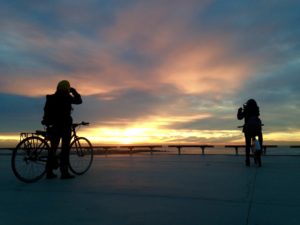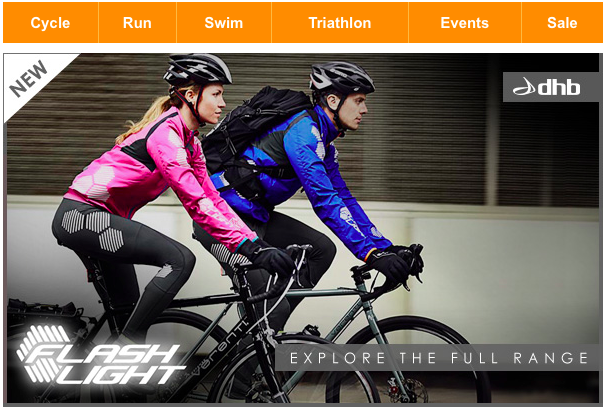This could be the best touring bike, ever. Why? Because it has been used for touring, real touring. It fills my mind with good memories and I’m so pleased I took those steps and went touring on it,
Technically, it has to be said, this fine machine might not be the best, not even in the early 1980s when this photo was taken by my good friend Wallie. These are the features of this fine machine:
- Steel frame of gas pipe quality and nothing fancy like that Reynolds 531 tubing which was all the rage at the time. It does have sufficient clearance for mudguards and fairly big tyres. Also there is a brazed on threaded boss for a fork-mounted light. No special mounts for gear levers or pannier racks though. Racks are attached via the mudguard eyes and the brake bolts for fixing onto the frame. The paint job is a unique classy metallic silver, hand finished complete with authentic brush strokes, chips, smudges and scrapes for the authentic hard-up student look
- Saddle: keen eyed readers will notice this isn’t a lovely Brooks B17 but a foam/plastic saddle which was probably about as cheap as you could get at the time
- Handlebars (or in today’s parlance “finishing kit”) were chromed steel and heavy. The tape was not luxurious cork or leather but self adhesive black cotton tape. The stem was also basic in chromed steel
- Wheels: eventually these were quite good, or at least the ones that I took to Africa (see below). The wheels in the photo, on the other hand, were probably those with ghastly chromed steel rims where the brake pads and their crude leather inserts would desperately try and grip the rims.
- Brakes: In the dry they were almost adequate on a good day. On a wet day they were pathetic, useless and bordering suicidal on steep hills and carrying a heavy load. They were, by the way, cheap side pull calliper brakes with cheap cables, outers linked to Weinmann leavers. At the time these were considered quite nice as they were aluminium and you could generally get spare parts
- Gears, transmission is somewhat lacking. With a floppy chainset featuring 42T and 52T chainrings this was the bog standard kit on almost every bike in the 1970s and 80s regardless of whether the bike was a “racer” or a “tourer”. Even so-called racers nowadays at least have compact chainsets with 50T & 34T chainrings; far more sensible. At the back was a 5 speed freewheel, YES 5 SPEED making the bike 10 speed. That seemed a lot in those good ol’ days, far removed from us talking 10, 11 or even 12 speed cassettes these days. The freewheel was something of an upgrade in bringing me a large sprocket of 28T. Wow that seemed great at the time but still woefully inadequate. Controlling the gears were two friction levers on the down tube, held on by a chromed band, nut and bolt, none of this fancy stuff we get these days. In case you don’t know, friction levers are those where there is no indexing or clicks – you have to “find” the gear you want by listening for a lack of the chain clattering around at the back, or even the front. It is akin to driving an old 1960s car without a synchromesh gearbox. Quaint.
- Lighting seen here are those heavy, sturdy Eveready battery lights that most people had at the time. They took two batteries which added to the weight and they never used to last very long. Using the fork braze-on fitting was great for the front light, holding it securely was very good until I wanted a front rack. Attaching the back light was always a problem.
- Other things not shown but used on my African adventure included a front rack with two spare tyres tied on. I remember these as they were quite expensive to buy – Specialized 27×1.3/8 and I remember were very tough. This rack was also used to strap my tent and sleeping bag on. Water bottles? Probably one or two. Lighting was a Soubitez dynamo, just behind the bottom bracket and pretty good, providing you were on the move. Luggage was a pair of mid range green Karrimor pannier bags and a matching handlebar bag. I still have these and use the panniers for shopping trips. I also had a Huret mechanical mileometer which attached to the front wheel. It looked cool but got bashed and fell off in my early days in Africa. Speaking of wheels, I had some made for me – these had 40 spokes and were strong with Weinmann concave rims – plus being aluminium the braking performance seemed utterly outstanding (at the time!).
- Clothing: I had no specific cycle clothing at all, certainly not a helmet. Most cycle clothing was too fancy and frumpy in any case. I was more keen on blending in once I’d arrived in Africa and this meant being scruffy and bedraggled (not hard for me to achieve)
So why, then, was this the best touring bike?
Simple. I had this bike when I was a teenager at school and used to go Youth Hosteling with a friend. While a student I cycled thousands of miles around Gloucestershire and even moved house with it! Taking it to Africa was the only thing I could do as I certainly couldn’t have afforded anything else.
It was a machine which was basic, crude, cheap and became a good friend. It enabled me to have so many wonderful experiences, to meet so many lovely people and see so many wonderful sights. It was there as I stepped out into the world as a young adult filled with wanderlust and a sense of adventure – that’s why it was the best touring bike, ever.
Related:





 RSS – Posts
RSS – Posts
Like hearing the story all over again but more entered on your bike. I did realy like hearing about that trip back in the mid 80s great times. Dee.